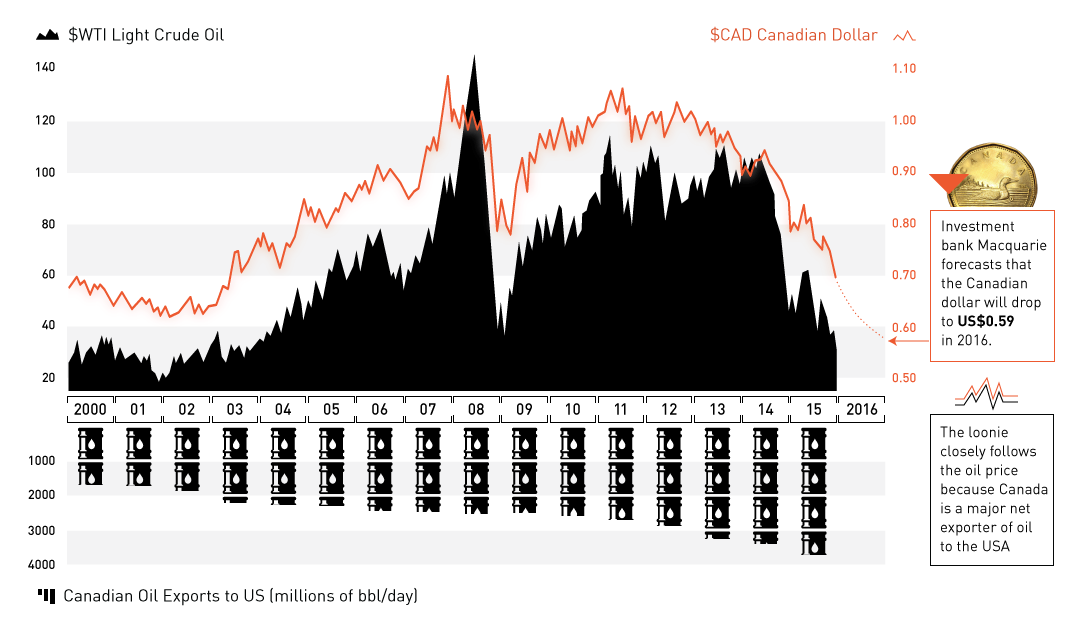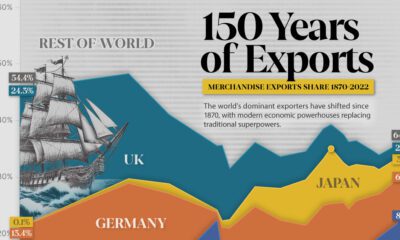Energy
Oil Bust Drags Canadian Dollar to Historic Lows [Chart]
![Oil Bust Drags Canadian Dollar to Historic Lows [Chart]](https://www.visualcapitalist.com/wp-content/uploads/2016/01/canadian-dollar-oil-historic-lows.png)
Oil Bust Drags Canadian Dollar to Historic Lows [Chart]
“Lower for longer” means loonie could hit US$0.59 by end of 2016
The Chart of the Week is a weekly Visual Capitalist feature on Fridays.
The continued pressure on the oil sector is wreaking havoc on the Canadian dollar.
This morning, the Loonie continued its freefall by losing another -1.1% , bringing the current exchange-rate to US$0.69. It’s the first time the Canadian dollar has traded below US$0.70 in 13 years, but the damage could be even worse.
David Doyle, a top forecaster for Macquarie Capital Markets, lowered his projection for 2016 to have the loonie finish at US$0.59. This would eclipse the all-time low for Canadian dollar, which was set on Jan 21, 2002, at just below US$0.62.
“Lower for Longer”
In this week’s chart, we show the well-established relationship between the Canadian dollar and the price of oil. Both prices have moved in tandem since 2000, and they’ve also both nosedived since the collapse of oil prices in mid-2014.
In fact, it may not surprise you to know that there are traders out there who use the Canadian dollar as a proxy for oil prices. If they think oil is going lower, they’ll sell Canadian dollars if it offers them the right kind of market exposure.
Oil is now trading at its lowest price since 2004, and many analysts believe that the pressure on prices will continue. Pundits are talking $20 oil and even $10 oil. While it’s very possible neither of those thresholds are reached, what is known is that low oil prices mean the Canadian dollar will continue to be under duress.
However, what are the specifics of this relationship? Canada is surely an economy that has a heavier reliance on raw materials, but it is no Saudi Arabia, right?
The Relationship Between Oil and the Canadian Dollar
The key to this relationship is based on two major principles.
Firstly, while Canada is a major producer of oil, it also exports the majority of this production to the United States. In 2014, Canada produced 4.4 million barrels of oil and equivalents per day, and it exported 3.4 million of this to the United States. Billions of US dollars are changing hands between American buyers and Canadian producers.
Oil prices are mostly traded in US dollars, which means that as the price drops, there are less US dollars being paid out to Canadian producers. This means producers are exchanging fewer US dollars for the Canadian dollars they need to pay wages and production costs. This drops the amount of “demand” for Canadian dollars, which affects the price of the currency.
Lastly, because oil is denominated in US dollars, the above effect gets further amplified by any other changes to the USD/CAD relationship. For example, while Canada has been loosening its monetary policy, the United States has been trying to do the opposite. This, along with other factors, has led to strength in the US dollar.
A strong dollar means cheaper oil. Cheaper oil means lower demand for Canadian dollars.
Energy
Charted: 4 Reasons Why Lithium Could Be the Next Gold Rush
Visual Capitalist has partnered with EnergyX to show why drops in prices and growing demand may make now the right time to invest in lithium.

4 Reasons Why You Should Invest in Lithium
Lithium’s importance in powering EVs makes it a linchpin of the clean energy transition and one of the world’s most precious minerals.
In this graphic, Visual Capitalist partnered with EnergyX to explore why now may be the time to invest in lithium.
1. Lithium Prices Have Dropped
One of the most critical aspects of evaluating an investment is ensuring that the asset’s value is higher than its price would indicate. Lithium is integral to powering EVs, and, prices have fallen fast over the last year:
| Date | LiOH·H₂O* | Li₂CO₃** |
|---|---|---|
| Feb 2023 | $76 | $71 |
| March 2023 | $71 | $61 |
| Apr 2023 | $43 | $33 |
| May 2023 | $43 | $33 |
| June 2023 | $47 | $45 |
| July 2023 | $44 | $40 |
| Aug 2023 | $35 | $35 |
| Sept 2023 | $28 | $27 |
| Oct 2023 | $24 | $23 |
| Nov 2023 | $21 | $21 |
| Dec 2023 | $17 | $16 |
| Jan 2024 | $14 | $15 |
| Feb 2024 | $13 | $14 |
Note: Monthly spot prices were taken as close to the 14th of each month as possible.
*Lithium hydroxide monohydrate MB-LI-0033
**Lithium carbonate MB-LI-0029
2. Lithium-Ion Battery Prices Are Also Falling
The drop in lithium prices is just one reason to invest in the metal. Increasing economies of scale, coupled with low commodity prices, have caused the cost of lithium-ion batteries to drop significantly as well.
In fact, BNEF reports that between 2013 and 2023, the price of a Li-ion battery dropped by 82%.
| Year | Price per KWh |
|---|---|
| 2023 | $139 |
| 2022 | $161 |
| 2021 | $150 |
| 2020 | $160 |
| 2019 | $183 |
| 2018 | $211 |
| 2017 | $258 |
| 2016 | $345 |
| 2015 | $448 |
| 2014 | $692 |
| 2013 | $780 |

3. EV Adoption is Sustainable
One of the best reasons to invest in lithium is that EVs, one of the main drivers behind the demand for lithium, have reached a price point similar to that of traditional vehicle.
According to the Kelly Blue Book, Tesla’s average transaction price dropped by 25% between 2022 and 2023, bringing it in line with many other major manufacturers and showing that EVs are a realistic transport option from a consumer price perspective.
| Manufacturer | September 2022 | September 2023 |
|---|---|---|
| BMW | $69,000 | $72,000 |
| Ford | $54,000 | $56,000 |
| Volkswagon | $54,000 | $56,000 |
| General Motors | $52,000 | $53,000 |
| Tesla | $68,000 | $51,000 |
4. Electricity Demand in Transport is Growing
As EVs become an accessible transport option, there’s an investment opportunity in lithium. But possibly the best reason to invest in lithium is that the IEA reports global demand for the electricity in transport could grow dramatically by 2030:
| Transport Type | 2022 | 2025 | 2030 |
|---|---|---|---|
| Buses 🚌 | 23,000 GWh | 50,000 GWh | 130,000 GWh |
| Cars 🚙 | 65,000 GWh | 200,000 GWh | 570,000 GWh |
| Trucks 🛻 | 4,000 GWh | 15,000 GWh | 94,000 GWh |
| Vans 🚐 | 6,000 GWh | 16,000 GWh | 72,000 GWh |
The Lithium Investment Opportunity
Lithium presents a potentially classic investment opportunity. Lithium and battery prices have dropped significantly, and recently, EVs have reached a price point similar to other vehicles. By 2030, the demand for clean energy, especially in transport, will grow dramatically.
With prices dropping and demand skyrocketing, now is the time to invest in lithium.
EnergyX is poised to exploit lithium demand with cutting-edge lithium extraction technology capable of extracting 300% more lithium than current processes.

-

 Lithium5 days ago
Lithium5 days agoRanked: The Top 10 EV Battery Manufacturers in 2023
Asia dominates this ranking of the world’s largest EV battery manufacturers in 2023.
-

 Energy1 week ago
Energy1 week agoThe World’s Biggest Nuclear Energy Producers
China has grown its nuclear capacity over the last decade, now ranking second on the list of top nuclear energy producers.
-

 Energy1 month ago
Energy1 month agoThe World’s Biggest Oil Producers in 2023
Just three countries accounted for 40% of global oil production last year.
-

 Energy1 month ago
Energy1 month agoHow Much Does the U.S. Depend on Russian Uranium?
Currently, Russia is the largest foreign supplier of nuclear power fuel to the U.S.
-

 Uranium2 months ago
Uranium2 months agoCharted: Global Uranium Reserves, by Country
We visualize the distribution of the world’s uranium reserves by country, with 3 countries accounting for more than half of total reserves.
-

 Energy3 months ago
Energy3 months agoVisualizing the Rise of the U.S. as Top Crude Oil Producer
Over the last decade, the United States has established itself as the world’s top producer of crude oil, surpassing Saudi Arabia and Russia.
-

 Science1 week ago
Science1 week agoVisualizing the Average Lifespans of Mammals
-

 Markets2 weeks ago
Markets2 weeks agoThe Top 10 States by Real GDP Growth in 2023
-

 Demographics2 weeks ago
Demographics2 weeks agoThe Smallest Gender Wage Gaps in OECD Countries
-

 United States2 weeks ago
United States2 weeks agoWhere U.S. Inflation Hit the Hardest in March 2024
-

 Green2 weeks ago
Green2 weeks agoTop Countries By Forest Growth Since 2001
-

 United States2 weeks ago
United States2 weeks agoRanked: The Largest U.S. Corporations by Number of Employees
-

 Maps2 weeks ago
Maps2 weeks agoThe Largest Earthquakes in the New York Area (1970-2024)
-

 Green2 weeks ago
Green2 weeks agoRanked: The Countries With the Most Air Pollution in 2023













